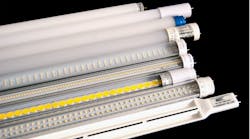The Department of Energy's CALiPER program performed a series of investigations on linear LED lamps. Each report in the series covers the performance of up to 31 linear LED lamps, which were purchased in late 2012 or 2013. The first report focuses on bare lamp performance of LED T8 replacement lamps, and subsequent reports examine performance in various troffers, as well as cost-effectiveness. There is also a concise guidance document that describes the findings of the Series 21 studies and provides practical advice to manufacturers, specifiers, and consumers. Report 21.4 was just released in June.
Video: LED Linear Lamps and Troffer Lighting: CALiPER Report Series 21Application Summary Report 21: Linear (T8) LED Lamps
This report focuses on the bare lamp performance of 31 linear LED lamps intended as an alternative to T8 fluorescent lamps. Data obtained in accordance with IES LM-79-08 indicated that the mean efficacy is similar to that of fluorescent lamps, but that lumen output is often much lower. This presents a situation where something must change in order for energy savings and equivalent illumination levels to be achieved simultaneously. In this case, the luminous intensity distribution of all the tested lamps was directional or semi-directional, rather than omnidirectional.
Also discussed in this report are several issues related to the electrical configuration of the lamps, such as the required socket types and power feed location. While no configuration is necessarily better, the multitude of options can make specifying and installing linear LED lamps more difficult, with the potential for safety issues. Similarly, the variety of color and power quality attributes adds a layer of complexity to the specification process. Many products offered good or excellent quality attributes, but some did not and thus could be perceived as inferior to fluorescent lamps in some installations. (31 pages, March 2014)
Report 21.1: Linear (T8) LED Lamps in a 2×4 K12-Lensed Troffer
This report focuses on the performance of the same 31 linear LED lamps operated in a typical troffer with a K12 prismatic lens. In general, luminaire efficacy is strongly dictated by lamp efficacy, but the optical system of the luminaire substantially reduces the differences between the luminous intensity distributions of the lamps. While the distributions in the luminaire are similar, the differences remain large enough that workplane illuminance uniformity may be reduced if linear LED lamps with a narrow distribution are used. At the same time, linear LED lamps with a narrower distribution result in slightly higher luminaire efficiency. (23 pages, April 2014)
Report 21.2: Linear (T8) LED Lamp Performance in Five Types of Recessed Troffers
Although lensed troffers are numerous, there are many other types of optical systems as well. This report looks at the performance of three linear (T8) LED lamps—chosen primarily based on their luminous intensity distributions (narrow, medium, and wide beam angles)—as well as a benchmark fluorescent lamp in five different troffer types. Also included are the results of a subjective evaluation. Results show that linear (T8) LED lamps can improve luminaire efficiency in K12-lensed and parabolic-louvered troffers, effect little change in volumetric and high-performance diffuse-lensed type luminaires, but reduce efficiency in recessed indirect troffers. These changes can be accompanied by visual appearance and visual comfort consequences, especially when LED lamps with clear lenses and narrow distributions are installed. Linear (T8) LED lamps with diffuse apertures exhibited wider beam angles, performed more similarly to fluorescent lamps, and received better ratings from observers. Guidance is provided on which luminaires are the best candidates for retrofitting with linear (T8) LED lamps. (47 pages, May 2014)
Report 21.3: Cost-Effectiveness of Linear (T8) LED Lamps
Meeting performance expectations is important for driving adoption of linear LED lamps, but cost-effectiveness may be an overriding factor in many cases. Linear LED lamps cost more initially than fluorescent lamps, but energy and maintenance savings may mean that the life-cycle cost is lower. This report details a series of life-cycle cost simulations that compared a two-lamp troffer using LED lamps (38 W total power draw) or fluorescent lamps (51 W total power draw) over a 10-year study period. Variables included LED system cost ($40, $80, or $120), annual operating hours (2,000 hours or 4,000 hours), LED installation time (15 minutes or 30 minutes), and melded electricity rate ($0.06/kWh, $0.12/kWh, $0.18/kWh, or $0.24/kWh). A full factorial of simulations allows users to interpolate between these values to aid in making rough estimates of economic feasibility for their own projects. In general, while their initial cost premium remains high, linear LED lamps are more likely to be cost-effective when electric utility rates are higher than average and hours of operation are long, and if their installation time is shorter. (22 pages, May 2014)
In 2013, DOE completed a study that compared LED linear replacement lamps, retrofit kits, and dedicated LED troffers with fluorescent benchmark products in a simulated office space. Key findings highlight the benefits and potential problems likely to be encountered as LED options for lighting offices and classrooms become more popular, and offer valuable feedback for manufacturers of these products as well as specifiers and installers.



